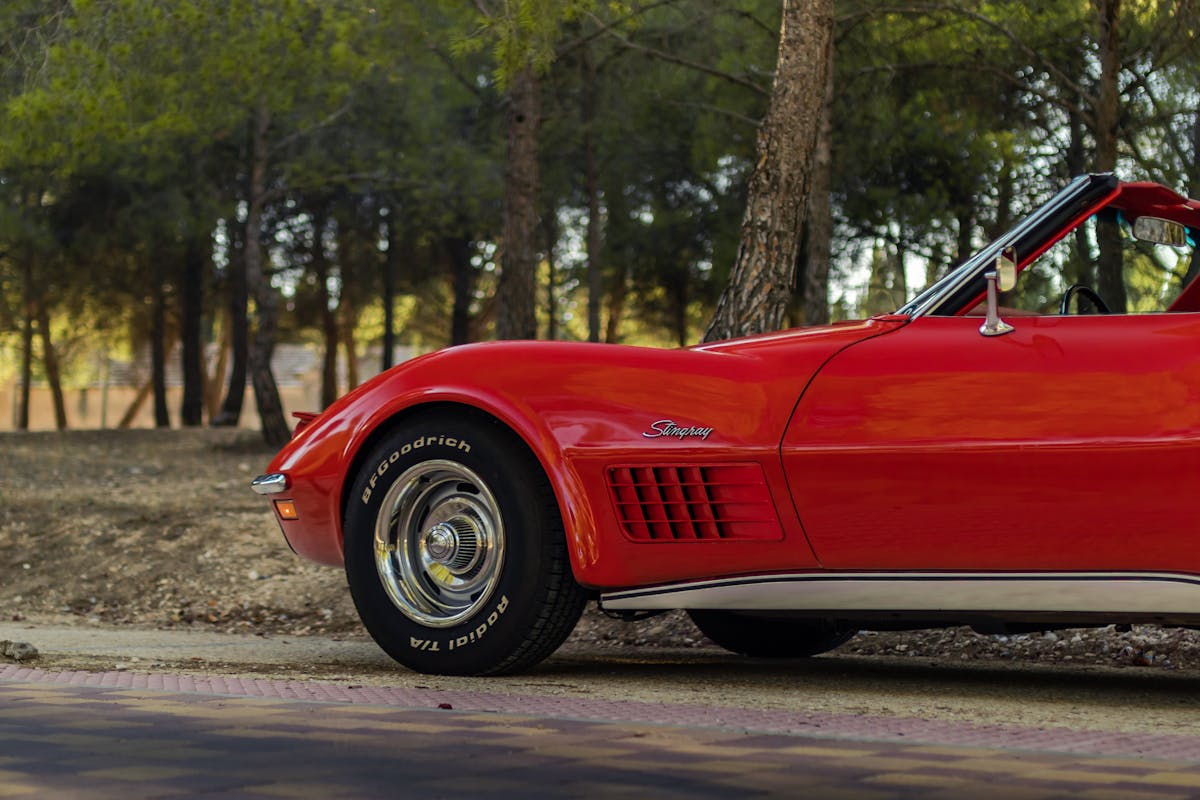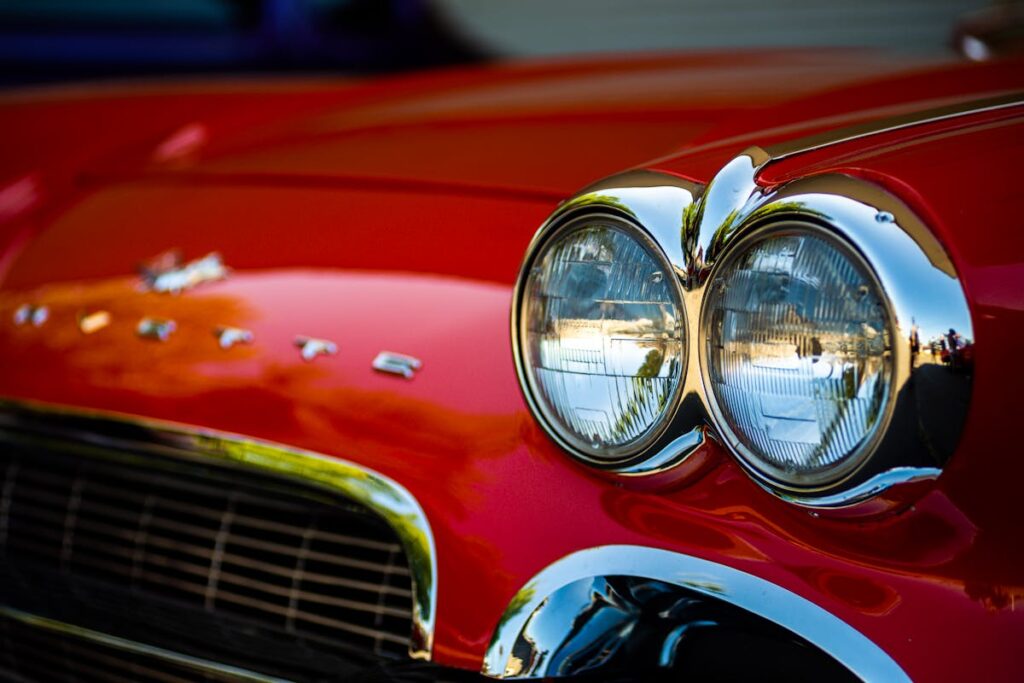The classic Corvette, with its sleek lines and potent performance, undeniably exudes an aura of seduction and power. However, this alluring appeal often accompanies a significant upkeep obligation. Routine maintenance tasks such as oil changes, fluid checks, and inspections are critical to maintaining its aesthetic and operational brilliance. Ignoring these responsibilities may result in expensive repairs and devaluation. As a result, it’s essential for Corvette owners to strike a balance between their enthusiasm for this iconic vehicle and the prudent care necessary for its preservation. This prompts the inquiry – is your classic Corvette as demanding as it is attractive?
The Allure of a Classic Corvette
There is an undeniable allure that envelopes the Classic Corvette, enchanting car enthusiasts around the world. This classic allure is not merely about its sleek design or the roar of its engine, it’s a visceral, tangible connection to an era of craftsmanship, aesthetics, and power. It is this unique blend of engineering and design, classic and contemporary, that gives the Classic Corvette its timeless appeal.
The Classic Corvette, with its streamlined body, chrome accents, and powerful engine, embodies the spirit of American ingenuity and the golden age of motoring. Each model tells a story, not just of its own journey, but of the era it hails from. Its appeal extends beyond the love for cars, reaching into the domain of art, history, and culture.
Its timeless appeal extends to its versatility. Whether it’s a weekend drive on a country road, a rally with fellow enthusiasts, or a simple display in a collector’s garage, it fits seamlessly. Its enduring charisma lies in its ability to adapt while maintaining its intrinsic qualities. The Classic Corvette is not just a car – it’s a reflection of the enduring allure of innovation and design.
Unveiling the Maintenance Reality
As we explore the world of Classic Corvette maintenance, we need to objectively address the reality of regular care needs. Acknowledging potential repair issues is equally important in order to guarantee the vehicle’s longevity and performance. Ultimately, owning a Classic Corvette is about striking a balance between style and the effort needed to maintain such a cherished piece of automotive history.
Corvette’s Regular Care Needs
Diving into the domain of Corvette maintenance, it quickly becomes clear that regular care is far from an optional luxury; it’s an absolute requirement for these classic vehicles. Owning a Corvette is akin to owning a piece of history, a mechanical marvel that demands constant attention and meticulous care.
The first and foremost aspect of Corvette maintenance is engine care. The heart of this classic beast requires regular servicing to guarantee it continues to roar with the same vigor and power as when it first graced the roads. Regular oil changes, spark plug replacements, and valve adjustments are just some of the routine tasks necessary to keep your Corvette’s engine in top shape.
Next, fluid checks are of utmost importance. The lifeblood of your Corvette, fluids such as engine oil, coolant, and brake fluid, need to be checked and replaced at regular intervals. These are the arteries through which your Corvette’s crucial systems operate and they should never be neglected.
Handling Potential Repair Issues
Often, Corvette owners are confronted with the harsh reality of potential repair issues. These issues, if not properly handled, can tarnish the experience of owning such a classic automobile. As a result, it is essential to understand the importance of repair diagnostics in identifying and addressing these potential issues.
Repair diagnostics enable you to detect problems before they escalate into more significant and potentially more costly concerns. For instance, a diagnostic may reveal a minor oil leak that, if left unattended, could result in engine damage. Consequently, regular diagnostic checks are a wise investment for the health of your Corvette.
However, diagnostics are just the start. Once a problem is identified, it must be rectified. This is where maintenance budgeting comes into play. Owning a classic Corvette means setting aside a budget for potential repairs. It’s not about the possibility of something going wrong, it’s about being prepared when it does.
Balancing Style and Effort
Striking a balance between style and effort is the cornerstone of classic Corvette maintenance. The allure of these vehicles lies in their timeless appeal, the embodiment of American automotive history crafted into curves and chrome. It’s the quintessential embodiment of style sustainability, a demonstration of enduring design principles. However, keeping this style alive requires a dedicated maintenance mindset.
Maintenance is not merely an act of preservation; it’s a process of renewal and continuous improvement. Understanding this is crucial for any classic Corvette owner. Vintage vehicles are not like modern cars; they demand a different level of attention, a passionate commitment often likened to a labor of love. Underpinning this is a blend of technical expertise and an appreciation for the artistry involved in the Corvette’s design and manufacturing process.
The reality of owning a classic Corvette is that it’s as much about admiring its aesthetic appeal as it is about understanding its mechanical intricacies. Balancing style and effort in maintenance is about acknowledging this symbiosis. The beauty of a classic Corvette is maintained not just in its glossy exterior but in the meticulous care taken to keep it running smoothly. It’s a delicate dance, a constant equilibrium between form and function.
Hidden Costs of Classic Car Ownership
While the allure of owning a classic Corvette is undeniable, prospective buyers must be conscious of the myriad hidden costs associated with such ownership. These costs often reach far beyond the initial purchase price, turning what seems like a dream into a financial nightmare if not properly managed.
Indeed, understanding these potential expenses can help prospective Corvette owners make informed decisions. Some of the hidden costs include:
- Insurance costs: Classic cars often require specialized insurance, which can be considerably more expensive than standard auto insurance.
- Storage expenses: Classic Corvettes require proper storage to maintain their condition, which can lead to additional costs.
- Restoration investments: These vehicles often require extensive and expensive restorations.
- Fuel Consumption: Older engines often consume more fuel than modern ones, leading to higher operating costs.
- Valuation fluctuations: The market for classic cars can be volatile, with values fluctuating wildly based on trends and economic conditions.
In addition to these costs, owners may also face registration fees, customization costs, event participation expenses, detailing requirements, and emission compliance costs. Despite these challenges, the allure and satisfaction of owning a classic Corvette often outweigh the hidden costs. However, potential buyers should always understand these considerations before purchasing.
Common Issues With Vintage Corvettes
The allure of a vintage Corvette can quickly be dampened by the common mechanical and structural issues these classic cars may possess. The engine is often the first to exhibit signs of distress, with problems ranging from engine overheating due to a compromised cooling system, to issues with the fuel system that can hamper performance.
Electrical issues, too, are not uncommon in these classics. The wiring systems in older Corvettes may be outdated, leading to sporadic or continuous electrical failures that can be both frustrating and hazardous.
One cannot overlook the structural issues either. Body rust is a pervasive problem, especially in models that haven’t been well-preserved. Suspension problems and brake wear are also frequent offenders, resulting in a less than smooth ride and compromised safety.
The transmission, integral to the car’s performance, can present issues over time, leading to jerky shifts or even complete failure. Tire wear, often exacerbated by suspension problems, is another area of concern.
Lastly, there’s the interior deterioration – a sad sight in a car once known for its stylish and comfortable cabin. Despite these issues, the love for these classic beauties continues, a reflection of their enduring appeal.

Tips to Reduce Maintenance Hassle
Maintaining a classic Corvette should be a pleasure, not a chore. A well-planned routine maintenance schedule, a toolbox stocked with essential spare parts, and a little hands-on DIY Corvette care can transform a potentially overwhelming task into a manageable, satisfying project. Embrace these tips and your Corvette will reward you with performance that matches its stunning looks, while minimizing the hassle of upkeep.
Routine Maintenance Schedule
As a proud owner of a classic Corvette, you understand the importance of routine maintenance. Keeping your beloved vehicle in top shape not only extends its lifespan but also enhances your driving experience. A meticulous maintenance schedule can be an effective tool to guarantee that your Corvette continues to turn heads and perform admirably on the road.
Here are some vital steps to follow:
- Regular oil changes and fluid checks are essential to keep your Corvette’s engine running smoothly. These should be performed every 3,000 to 5,000 miles.
- Tire rotations and brake inspections should be carried out every 6,000 miles to guarantee safety and peak performance.
- A thorough engine tuning at intervals of 10,000 to 12,000 miles can greatly improve your Corvette’s performance.
- Battery maintenance and interior care are also important. Regular cleaning and checking for corrosion can help prevent unexpected breakdowns.
- Finally, consider seasonal storage strategies, detailing tips, and paint protection to maintain your Corvette’s sexy look.
Essential Spare Parts
Having a well-structured maintenance schedule is undeniably a smart approach to preserving the performance and allure of your classic Corvette. However, it is equally important to keep a stock of essential spare parts, an aspect that often goes unnoticed. The availability of these key components can not only reduce the downtime of your prized possession but also save you from the stress of sudden breakdowns.
Among the most vital components are the fuel pump, alternator, and ignition coil. These are the heart and soul of your vehicle, ensuring peak performance and driving experience. It’s wise to invest in high-quality aftermarket upgrades for these parts, which often offer improved durability and performance over their OEM counterparts.
Other essential components to take into account include brake pads, spark plugs, and oil filters. Regular replacement of these parts can greatly extend the lifespan of your classic Corvette and enhance its performance.
DIY Corvette Care
In the domain of classic Corvette maintenance, embracing a do-it-yourself approach can not only be rewarding but also greatly reduce the stress and expense of upkeep. With the right knowledge, a few tools, and a bit of passion, you can guarantee your classic Corvette remains in pristine condition, radiating its timeless elegance.
- Corvette Cleaning and Paint Protection: Regular cleaning is crucial, and applying a high-quality paint protection can preserve the lustrous finish of your classic Corvette.
- DIY Upgrades and Interior Restoration: Simple DIY upgrades can enhance your Corvette’s performance. Restoring the interior to its original glory can add immense value.
- Engine Tuning and Fluid Checks: Regular engine tuning and fluid checks can prevent costly repairs and improve your Corvette’s overall performance.
- Tire Care and Electrical Maintenance: Proper tire care is essential for a smooth ride, and regular electrical maintenance guarantees all systems are go.
- Weatherproofing Tips and Vintage Detailing: Protect your Corvette from harsh weather conditions with effective weatherproofing. Vintage detailing will maintain its classic charm.
Implementing these DIY Corvette care tips will guarantee your classic beauty remains sexy without being high maintenance.
Preserving Your Corvette’s Aesthetics
Maintaining the iconic beauty of your Corvette requires both dedication and an understanding of the car’s unique aesthetic characteristics. The gleaming paintwork is a key aspect of its allure, demanding special attention. Paint protection, using high-quality sealants, provides a barrier against harmful elements like UV rays, road salts, and bird droppings, thereby preserving the original shade and sheen.
In addition to paint protection, regular detailing is an integral part of preserving your Corvette’s aesthetics. Employing proper detailing techniques guarantees that every curve and detail of your classic Corvette remains pristine. Detailing involves a meticulous process of cleaning, restoring, and finishing, imparting a show-quality level of detail. Consider investing in professional-grade detailing tools and products to achieve the best results.
Preserving the aesthetics of your Corvette also extends to its interiors. Regular cleaning and conditioning of the leather upholstery keep it soft and prevent cracks. The dashboard, steering wheel, and other surfaces require regular dusting and polishing too.
Preserving the aesthetics of your Corvette is not just about maintaining its looks; it’s about honoring its heritage. Remember, your Corvette is not simply a car; it’s a classic, a piece of automotive history that deserves your care and attention.
Boosting Performance of Your Classic
Beyond the striking aesthetics of your classic Corvette lies a powerhouse of performance, waiting to be set free. Releasing this latent potential involves a combination of performance upgrades and expert engine tuning, tailored to highlight the unique character of your classic Corvette.
The journey to boosting your Corvette’s performance can be as rewarding as the end result, especially when you adhere to the following steps:
- Engine Overhaul: Improve horsepower and torque by upgrading key engine components.
- Exhaust System Upgrade: Enhanced exhaust systems can increase power and give your Corvette that distinct, throaty roar.
- Suspension Modifications: Better handling comes with a finely tuned suspension, offering a smoother ride and superior control.
- Brake System Upgrade: Performance isn’t just about speed; upgraded brakes provide safer and more responsive stopping power.
- Engine Tuning: Fine-tuning the engine settings can optimize performance, fuel efficiency, and longevity.
While these performance upgrades might seem challenging, they’re an investment into the heart of your classic Corvette. With each upgrade, your Corvette becomes more than a showpiece, transforming into a machine that matches its looks with exhilarating performance. You’ll find that the thrill of driving your high-performance classic Corvette is incomparable to any other driving experience.
Making the Most of Your Investment
Investing in a classic Corvette is more than just purchasing a car; it’s about embracing a piece of automotive history and preserving its legacy for future generations. To guarantee that your Corvette continues to appreciate in value, implementing strategic investment strategies is essential.
Think about starting with a thorough maintenance and restoration plan. Classic Corvettes require meticulous care, from the engine to the upholstery. Regular servicing not only guarantees peak performance but also helps to preserve the original features that make these vehicles so desirable. The more original the vehicle, the higher its potential for value appreciation.
Next, reflect on storage options. A classic Corvette is not a daily driver and should be stored in a climate-controlled environment to prevent damage and degradation. Proper storage is an investment that pays dividends in the long run.
Lastly, stay informed about the classic car market. Understanding market trends can help you decide when to invest in improvements or when to think about selling. The classic Corvette market is influenced by various factors, including scarcity, demand, and historical significance.
Frequently Asked Questions
What Is the Typical Insurance Cost for a Classic Corvette?
The typical insurance cost for a classic Corvette varies greatly, influenced by insurance factors such as age, driving record, and location. Coverage options also play an important role, with extensive packages costing more.
Are There Specific Driving Techniques to Extend the Lifespan of My Vintage Corvette?
Yes, adopting specific driving habits can prolong your vintage Corvette’s life. Regular maintenance, gentle acceleration, avoiding hard braking, and timely oil changes are essential. Your classic beauty’s longevity depends largely on your careful handling and upkeep.
Can I Use Regular Fuel for My Classic Corvette or Does It Require Premium?
Classic Corvettes generally require premium fuel due to their high-compression engines. Using regular fuel can lead to subpar engine performance and potential damage due to lower fuel octane, compromising the longevity and brilliance of your vintage vehicle.
What Is the Resale Value Trend for Classic Corvettes Over the Past Decade?
The resale value of classic Corvettes has seen notable increases over the past decade, driven by market fluctuations and heightened collector demand. However, specific values can vary greatly based on model, condition, and rarity.
How Does Climate and Weather Affect the Condition of a Classic Corvette?
Climate and weather greatly impact a classic Corvette’s condition. Weather can cause physical damage, while climate considerations may speed deterioration. Regular maintenance is essential to mitigate these effects and preserve the vehicle’s aesthetic and functional appeal.

